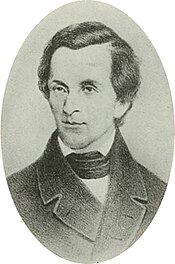 An illustration of Edward Bonney, the bounty hunter and amateur detective who in 1845 posed as a counterfeiter (who ironically had been arrested for counterfeiting himself a few years earlier) to infiltrate a faction of the "Banditti of the Prairie" and track down the infamous murderers of Colonel George Davenport: Bonney wrote the 1850 book The Banditti of the Prairies: or, The murderer's doom, a tale of Mississippi Valley and the Far West | |
| Years active | 1830s-1850 |
|---|---|
| Territory | Primarily, Lee, DeKalb, Ogle, Winnebago, Rock Island, Jo Daviess, and Hancock counties, in Illinois as well as the states of Iowa, Indiana, and Ohio |
| Ethnicity | European-American |
| Membership (est.) | ? |
| Criminal activities | house burglary, fencing stolen property, horse and cattle theft, stagecoach and highway robbery, counterfeiting, murder |

The Banditti of the Prairie, also known as The Banditti, Prairie Pirates, Prairie Bandits, and Pirates of the Prairie, in the U.S. states of Illinois, Indiana, and Ohio and the Territory of Iowa, were a group of loose-knit outlaw gangs, during the early to mid-19th century. Though bands of roving criminals were common in many parts of Illinois, the counties of Lee, DeKalb, Ogle, and Winnebago were especially plagued by them.[1] The new crime wave in the region of the frontier Midwest may have occurred following the crackdown on Southern outlaws by the rising vigilante-regulator movement and the breakup of the criminal syndicate of John A. Murrell and his gang, the "Mystic Clan", in the Southern United States. In 1841, the escalating pattern of house burglary, horse and cattle theft, stagecoach and highway robbery, counterfeiting and murder associated with the Banditti had come to a head in Ogle County. As the crimes continued, local citizens formed bands of vigilantes known as Regulators. A clash between the Banditti and the Regulators in Ogle County near Oregon, Illinois resulted in the outlaws' demise and decreased Banditti activity and violent crime within the county.
Banditti and Regulator activity continued well after the lynching that took place in 1841. Crimes continued, committed by both sides, across northern and central Illinois. The Banditti were involved in other notable events, as well, including the 1845 torture-murder of merchant Colonel George Davenport, the namesake of Davenport, Iowa. Edward Bonney, an amateur detective who hunted down and brought to justice the killers, wrote of his exploits and alibi, which were recounted in his book Banditti of the Prairies, or the Murderer's Doom!!: A Tale of the Mississippi Valley, published in Chicago in 1850. The outlaw gangs also continued to be active in Lee and Winnebago Counties following the events in Oregon.




- ^ Channick, Herbert S. The Regulators and the Prairie Bandits Archived 2006-09-10 at the Wayback Machine, Illinois Heritage, 2002, Illinois Periodicals Online, Northern Illinois University Libraries. Retrieved March 5, 2007.